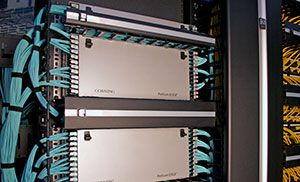.jpg)
It’s safe to say that the advent of fiber optic cable solutions has been one of the best things to happen to technology in recent years. As fiber optic cables carry signals via light rather than electricity, they can travel much greater distances (up to 5,000 miles) and at quicker speeds (up to 10 GB a second) than their coaxial counterparts. Less vulnerable to electrical interference as well, fiber optic cables are able to deliver these signals much more smoothly, often without having to boost or clean a signal that has traveled even a great distance. So with the demand on technology ever-increasing, fiber optic cables are becoming the preferred method of transmission over traditional coaxial solutions.
But how to integrate the demands which the new physical topology of fiber places on cabling installation and maintenance processes?
For starters, the National Electric Contractors Association (NECA), along with the Fiber Optic Association (FOA) jointly developed the "NECA/FOA 301-2009 Standard for Installing and Testing Fiber Optics," which addresses the emergent demands that fiber optic cables present in the technology environment. The Safety and Installation sections of the NECA/FOA 301-2009 use Occupational Safety and Health Administration (OSHA) and National Electric Code (NEC) regulations to address the proper handling of fiber optic cables during installation and maintenance.
If you are considering using fiber optic cables in your installation, take a moment to review a selection of these procedures, and see how Chatsworth Products provides you with the products and tools that allow you to adhere to the below guidelines.
- Allow for future growth in the quantity and size of cables when determining the size of the pathway bend radius requirements.
- Try to complete the installation in one pull. Prior to any installation, assess the route carefully to determine the methods of installation and obstacles likely to be encountered.
Fiber optic cables are more susceptible to damage during the stress of installation, therefore there are two specifications for bend radii—Bend Radii before installation and Bend Radii after installation. See the table below for estimating proper bend radii:
| Use |
Pulling |
At Rest |
| To Work Area (1 to 4 Strands) |
2” (50 mm) inch radius |
1” (25 mm) radius |
| Inside plant |
15 times OD |
10 times OD |
| Outside Plant |
20 times OD |
10 times OD |
Source: EIA/TIA 568 Standard for Fiber Optics
- Check the cable length to make sure the cable being pulled is long enough for the run.
- Try to complete the installation in one pull. Prior to installation, asses the route carefully to determine the methods of installation and obstacles likely to be encountered.
- When laying loops of fiber on a surface during a pull, use “figure-8” loops to prevent twisting the cable.
- All hardware and support structures should follow the recommendations of TIA-569 and NECA/BICSI 568 Standards documents.
- Do not exceed the cable bend radius. Fiber optic cables can be broken when kinked or bent too tightly, especially during pulling.
- Drop vertical cables down rather than pulling them up.
- Support cables at frequent intervals to prevent excess stress on the cable jackets.
- Use cable management straps or cable ties to support cable bundles. Make sure these implements are fastened snugly, but not tightly around cable bundles.
Pro tip: CPI offers a vast selection of Cable Runway Products and accessories that meet ANSI, TIA and EIA guidelines for supporting both fiber and copper cables. In addition, use CPI’s line of Saf-T Grip® Cable Management Straps to support cable bundles.
- Small scraps of bare fiber produced as part of the termination and splicing process must be properly disposed in a safe container. Follow your local regulations – in some areas this material may be considered hazardous waste.
- Thoroughly clean the work area when finished, do not use compressed air to clean off the work area.
- The small size of optical fibers makes them very sensitive to dust and dirt. Maintain the highest standards of cleanliness when working with fiber optic cables to optimize its performance.

Pro tip: CPI’s Evolution®, Velocity® and Universal Horizontal Cable Managers are designed to organize and secure both fiber and copper cables, and have snap on covers which protect cables during installation and use as well as promote an organized and secure appearance.
- Though fiber optic cables are generally all-dielectric, power should be disconnected for the duration of the installation process when working in areas that have installed electrical hardware and power cables.
- Fusion splicers create an electric arc. Ensure that there are no flammable vapors and/or liquids present. Do not use in confined spaces as defined by OSHA.
- Although most fiber optic cables are non-conductive, any metallic hardware used in fiber optic cabling systems (such as wall-mounted termination boxes, racks and patch panels) must be grounded.
Pro tip: CPI offers a comprehensive line of UL Listed Grounding and Bonding products to help prevent transient voltage from damaging sensitive electronic equipment.
In addition to our selection of products and tools, CPI has a team of skilled technical support specialists who can assist you in designing your solutions. Contact our technical support team by calling 1-800-834-4969, or by filling out a customer support request here.
by Kathryn Salter, Technical Writer